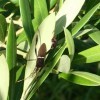Abstract
Olive production in Florida has increased over the last few years. As trees become available in nurseries many homeowners are planting them in their landscapes. Fortunately, olives are a relatively pest-free species, but some occasional invaders can be a nuisance or cause lasting harm. A few plant pathogens that may infect olives also can lead to a decline in overall plant health, fruit yield, or the visual appearance of plants. Following correct cultural practices when growing olives can reduce your chances of tree loss from pests and diseases. A survey of olive production and interviews with Florida growers in 2014 identified the pests and diseases described in this 5-page fact sheet, written by Jennifer L. Gillett-Kaufman, Sandra A. Allan, Jonael H. Bosques-Mendez, and Lyle J. Buss, and published by the UF Department of Entomology and Nematology, September 2014.
ENY-871/IN1046: Pests and Fungal Organisms Identified on Olives (Olea europaea) in Florida (ufl.edu)
References
Capinera, J. L. 1992. Common grasshoppers in Florida. University of Florida Institute of Food and Agricultural Sciences. SP98/IN010. http://edis.ifas.ufl.edu/in010
Collins, L., and R. H. Scheffrahn. 2001. Red imported fire ant, Solenopsis invicta Buren (Insecta: Hymenoptera: Formicidae: Myrmicinae). University of Florida Institute of Food and Agricultural Sciences. EENY195/IN352. http://edis.ifas.ufl.edu/in352
Conklin, T. and R. F. Mizell. 2002. Glassy-winged sharpshooter, Homalodisca vitripennis (=coagulata) (Germar) (Insecta: Hemiptera: Cicadellidae: Cicadellinae). University of Florida Institute of Food and Agricultural Sciences. EENY274/IN552. http://edis.ifas.ufl.edu/in552
Elliott, M., K. Pernezny, A. Palmateer and N. Havranek. 2008. Guidelines to identification and management of plant disease problems: Part I. Eliminating insect damage and abiotic disorders. University of Florida Institute of Food and Agricultural Sciences. PP248/MG441. http://edis.ifas.ufl.edu/mg441 https://doi.org/10.32473/edis-mg441-2008
Fasulo, T. R. and R. F. Brooks. 1994. Grasshopper, katydid and cricket pests of Florida citrus. University of Florida Institute of Food and Agricultural Sciences. ENY813/CH056. http://edis.ifas.ufl.edu/ch056
Fasulo, T. R. and R. F. Brooks. 1993. Scale pests of Florida citrus. University of Florida Institute of Food and Agricultural Sciences. ENY814/CH059 http://edis.ifas.ufl.edu/ch059
Hayden, J. E. and L. J. Buss. 2013. Olive shootworm, Palpita persimilis Munroe (Insecta: Lepidoptera: Crambidae). University of Florida Institute of Food and Agricultural Sciences. EENY556/IN995. http://edis.ifas.ufl.edu/in995 https://doi.org/10.32473/edis-in995-2013
Mizell, R. F. 2004. Stink bugs and leaffooted bugs are important fruit, nut, seed and vegetable pests. University of Florida Institute of Food and Agricultural Sciences. ENY718/IN534. http://edis.ifas.ufl.edu/in534
Villanueva, R. 1998. Tobacco hornworm, Manduca sexta (Linnaeus), and tomato hornworm, Manduca quinquemaculata (Haworth), (Insecta: Lepidoptera: Sphingidae). University of Florida Institute of Food and Agricultural Sciences. EENY031/IN158. http://edis.ifas.ufl.edu/in158
Weems, H. V. and J. L. Nation. 1999. Olive fruit fly, Bactrocera oleae (Rossi) (Insecta: Diptera: Tephritidae). University of Florida Institute of Food and Agricultural Sciences. EENY-113/IN270. http://edis.ifas.ufl.edu/in270

